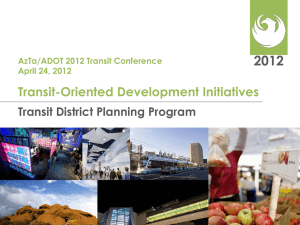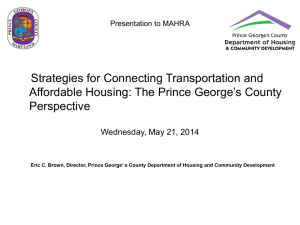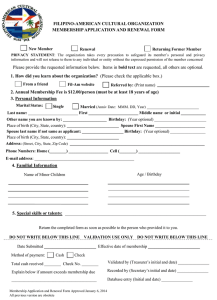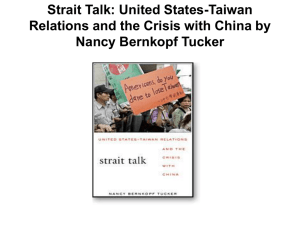Urban Renewal
advertisement
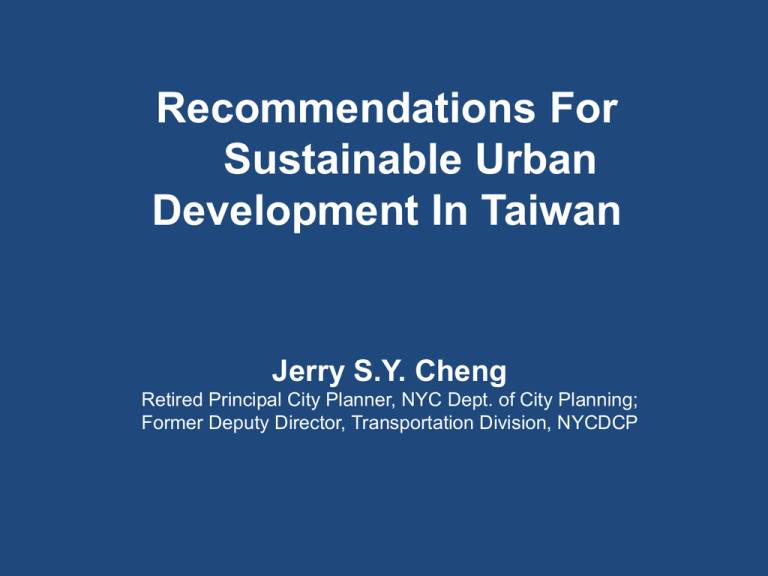
Recommendations For Sustainable Urban Development In Taiwan Jerry S.Y. Cheng Retired Principal City Planner, NYC Dept. of City Planning; Former Deputy Director, Transportation Division, NYCDCP Some Of The Current Major Issues Related To The Future Urban Development Of Taiwan: • • • • Record high aging population. Continued urbanization. Sharply increased ownership of private motor vehicles. Very low public transportation use. Taiwan’s Aging Population • The average annual population growth is slowing down drastically (from 2.1% in 1980 to 0.4% in 2010) and will reach zero growth soon. • The aging population (65 years and over) increased from 4.3% in 1980 to 10.7% in 2010. • The aging index (the ratio of the percentage of the population over 65 with that of those under 14) has reached record height, went from 39.4% in 1999 to 65.05% in 2009. The population of Taiwan was the oldest in Asia, with South Korea’s aging index at 58.82%, Singapore at 50%, mainland China at 42.11%, Malaysia at 12.5%, and the Philippines at 11.43% . Sharply Increased Ownership Of Private Motor Vehicles In Taiwan • • • The total number of motor vehicles registered has increased sharply in recent years, growing from 17,907 thousand in 2002 to 22,188 thousand in 2012, a 24% growth in 10 years. the number of registered private cars rose from 4,989 thousand to 6,039 thousand, a 21% growth. the number of motorcycles increased from 11,984 thousand to 15,019 thousand, a growth of some 25%. Ministry of Transportation and Communication (MOTC). Very Low Public Transportation Use • Private motor vehicle use continues to increase rapidly in Taiwan. • In the account of daily trips, about 74.1% were made by private vehicles (48.5% by motorcycles, 24.1% by private cars) and only 14.3% by public transportation. • In terms of private vehicle ownership, with a population of 23,188 thousand, every 3.8 persons own a passenger car; while every 1.5 persons own a motorcycle, which is the highest in the world. Survey conducted by MOTC in 2011 臺灣地區所有旅次公共運輸使用率-按縣市別分 100年調查期間:100年10月 4日至12月31日 99年調查期間:99年10月12日至12月30日 Department of Statistics, MOTC, March 2012 Transit-oriented Development (TOD) And Urban Renewal Are Critical Tools For Dealing With These Issues: • Current aging society needs new development policies for different types of housing and transportation. • Urban sprawl needs to be replaced with compact cities. • Vicious cycles (increased private motor vehicle ownership vs. low public transportation usage) need to be corrected. Sustainable Development • Sustainable development has long been promoted as the best answer to the world’s environmental problems. • In the urban context, sustainability issues have been reflected in the promotion of sustainable urban development, which emphasizes the sensible exploitation of scarce natural resources for urbanization in a manner that allows future generations to repeat the process. • Such development is also beneficial in meeting the needs of the community, with potential for addressing environmental and economic concerns. Suharto Teriman, Tan Yigitcanlar and Severine Mayere, “Sustainable Urban Development: An Integrated Framework for Urban Planning and Development,” 2010 Agenda 21 • The “21” referring to the 21st century. • A comprehensive plan of action to be taken globally, nationally and locally by organizations of the United Nations System. • Adopted by 178 nations at the UN Conference on Environmental and Development (the “Earth Summit”) in 1992. • After subsequent modifications and affirmations, the full implementation of Agenda 21 was reaffirmed at the World Summit on Sustainable Development in 2002. • Even though there have been skeptics (suspecting an urban planning conspiracy, international plot, etc.) of, criticism of, and opposition to Agenda 21, many countries and cities around the world see Agenda 21 as a useful guide for their own urban planning efforts. Taiwan Agenda 21 • In response to Agenda 21, the government of Taiwan officially promulgated the Taiwan Agenda 21 in 2000, which outlined strategies and guidelines “to achieve sustainable development.” • “Taiwan Agenda 21: Vision and Strategies for National Sustainable Development” was approved by the Council for National Sustainable Development, Executive Yuan in 2004. Lawrence W. LAN, “Sustainable Development and Transportation: A Taiwan Perspective”, 2005 Taiwan Agenda 21 Emphasized • For the sake of Taiwan’s sustainable development, it is essential that to promote energy-saving, lowpolluting mass transportation systems, to reduce traffic demand and congestion, and thus reduce the environmental pollution caused by transportation activities. • Should review relevant policies to reduce the number and usage of privately owned vehicles. Following the 2002 World Summit on Sustainable Development Conference The Chairman of the Urban Regeneration R&D Foundation in Taiwan in his 2005 paper “Recent Challenges to the Sustainable Development of Taiwan,” presents new challenges Taiwan Agenda 21 faces that will affect Taiwan’s sustainable development in the future. Chairman of the Urban Regeneration R&D Foundation in Taiwan, Lung-Shen Chang, Promotes “eco-innovation” for urban sustainability, a “moving away from suburban patterns of development in favor of dense, mixed-use urban neighborhoods with win-win social and environmental effects … [which include] a closer relation between working and living localities, increased use of public transit, walking and cycling, lower levels of car ownership and use, and increased support for local retailers versus suburban shopping malls.” Mr. Lung-Shen Chang, “Recent Challenges to the Sustainable Development of Taiwan” ,2005 Transportation Session of the 1992 National Development Seminar (國建會) One of the major subjects for discussion was on how the transportation systems in Taiwan have serious impact on the environmental, economic and social systems and on how the sharply increased ownership of private motor vehicles and very low public transportation use made the problem worse. Major efforts to correct the vicious cycle were proposed. The Organization of Economic Cooperation and Development ( OECD ) suggests that in order to make transportation systems sustainable, a “significant reduction in car ownership and use,” among other changes, is very critical. Lawrence W. Lan, “Sustainable Development and Transportation: A Taiwan Perspective,” 2005 Based on the Public Transportation Development Act Promulgated in 2002 The government has in many ways successfully made the public transportation system attractive and financially efficient. However, the policies and strategies for discouraging heavy use of private motor vehicles have not been adequate and satisfactory. Transportation Policy White Book First White Book (released by MOTC in 1995): The rationale for promoting public transportation and discouraging heavy use of private motor vehicles was clearly documented. Revised White Book ( 2002 ): More explicit policies and strategies for the development of public transport were clearly outlined. In an attempt to address these issues as they exist in Taiwan, and with sustainable development as the answer to most environmental concerns, this presentation will share U.S. experiences with TransitOriented Development (TOD) and Urban Renewal, and make recommendations for Taiwan’s sustainable urban development. Transit-oriented Development • An important tool for sustainable urban development. • A mixed-use community within walking distance of a transit facility that mixes residential, retail, office, open space, and public uses in a way that makes it convenient to travel on foot or by public transportation instead of by car. • Would encourage transit ridership and reduce the ownership and use of private motor vehicles. • The increasing population density around transit facilities can capitalize on transit investment. • Can provide alternative suburban living and working environments (an opportunity to live in the suburbs without being entirely dependent on the automobile). • Can provide neighborhood revitalization (a means of stimulating economic growth in blighted or declining areas served by rail or other transit). TOD has gained more acceptance in the United States over the past decades as a tool for: •Curbing sprawl and its resulting car dependence. •Promoting sustainability and smart growth. •Leveraging economic development. •Catering to shifting housing market demands and lifestyle preferences. TOD's Growing Popularity in USA • Increasing American environmental awareness after the 1990s. This awareness led to a valuing of Sustainability. • Many Americans began to rethink their lifestyles they began to regard cars and suburban life as environmental-unfriendly. • The U.S. is becoming an aging society, and a suburban lifestyle is not appealing for older people. To be continued TOD's Growing Popularity in USA • A response to traffic congestion that has been advancing urban sprawl. • A desire for a more pedestrian-friendly environment. • There has being an increasingly common theme in zoning code reform across the country. • Incentive zoning through the newer zoning codes, which provide for and encourage the use of TOD by allowing increased density at transit facilities. Definitions of TOD • • • • There is no universally accepted definition of TOD. TOD is viewed and defined differently throughout the U.S., with its most common traits being compact, mixed-use development near transit facilities and high quality walking environments. Transit agencies from New York City and San Francisco may claim that their “entire city met the definition of TOD.” The same can largely be said for other cities with centuryold rail services like Chicago, Philadelphia, and Boston. Benefits Of TOD • Increased transit ridership and fare revenues. • Reduced vehicle miles traveled (VMT) and therefore lowered regional congestion and air pollution. • Potential for added value created through increased and/or sustained property values. • Improved access to job centers and economic opportunity for low-income people and working families. • Walkable communities that accommodate more healthy and active lifestyles • Expanded mobility choices that reduce dependence on the automobile and promote public transportation usage. A Few Examples Of TOD And Urban Renewal Projects In USA The Far West Midtown plan To promote the transit-oriented development and urban renewal ,New York City’s No. 7 Subway Line Extension and the Hudson Yards Development project is a very unique and unusual case, mainly due to its funding source and the collaboration of city government and transportation agency from the onset in their mutually beneficial roles. The Far West Side In The Area Around Lincoln Tunnel Has: • Often been choked with cars waiting to get into the tunnel • Been littered with car dealerships and repair shops • Resembled a wasteland • Had slow buses as its only transit option The Far West Midtown Plan • • • The $2 billion subway Extension is paid for by New York City funds from municipal Tax Increment Financing (TIF) bond sales that are expected to be repaid with property tax revenues from future developments in areas served by the Extension. The approved rezoning for the Hudson Yards area allows for a mixed-use community, with millions of square feet of office, housing, hotel and retail development as well as park space with plazas. To transform this area into a vibrant, medium to high density extension of the Midtown business district. Far West Midtown Tax Increment Financing ( TIF ) • A public financing method which has been used as a subsidy for redevelopment and community improvement projects in many countries including the United States for more than 50 years. Similar or related approaches are used elsewhere in the world, such as value capture. • Allows governments and public agencies to raise funds based upon the anticipated increase in real estate tax revenues that will result from major infrastructure improvements. The Jamaica Rezoning Plan • • • • One of the largest rezoning, TOD and Urban Renewal efforts in New York City. The Jamaica Transportation Hub includes the new AirTrain, the Long Island Rail Road, subway and buses. To create a mixed-use TOD around the Hub which includes millions of square feet of commercial space, residential units, and retail. By making the Jamaica Station/Air Train Terminal easily accessible for users safer and more pleasant these TOD projects will enhance and increase ridership on Air Train, Long Island Rail Road and New York City Transit. Hudson-Bergen Light Rail Extension • • • • To extend Hudson-Bergen Light Rail (HBRL) in Jersey City to a new station 0.7 miles past its current terminus. To service the proposed Bayfront Redevelopment, a massive mixed-use Urban Renewal and TOD development project on an industrial site. The project includes 8,100 housing units and 1.8 million square feet of office and retail space, as well as a waterfront greenway, park space and plazas. The site’s owner, along with Jersey City and NJ Transit, all have something to gain by seeing the site redeveloped, and all play a major role in enabling that to happen. The Atlanta Beltline, George • • • • • America’s most ambitious TOD and Urban Renewal project, on the site of an abandoned rail and industrial corridor. To invest some $2.8 billion in a new, 22-mile public transit, trails, and parks loop around the heart of the city of Atlanta. Because the BeltLine passes through some of the inner city's most distressed neighborhoods, the intent is for this major public investment to leverage substantial private investment in revitalization, particularly workforce housing. The new transit is connecting in several places along the loop to the MARTA regional rail transit system. The project wants to ensure that the 3,000 acres of underutilized or idled industrial property around the BeltLine redevelop in ways that enhance livability and quality of life. Tools for Effective TOD • Accommodate pedestrians. Reflect a pedestrian-orientation in built environments. Every transit trip begins and ends on foot, dictating a pedestrian emphasis. • Improve access from transit to jobs and residences. Locate new development in proximity to transit opportunities. • Move from node to place. Create places for people, not cars. A place-making orientation should take precedence over creating a node for commuters and drivers. • Resolve fiscal challenges and barriers. Continue diligent attention to resolution of public and private fiscal barriers. • Depoliticize transit service. More fully fund transit operations and focus new service in areas with the greatest demand for transit service. To be continued Tools For Effective TOD • Integrate views among actors. Approach urban centers and TODs in an interdisciplinary fashion. • Enhance leadership and vision. Continue leadership and articulation of a regional vision. • Enhance Transportation Demand Management (TDM) and related tools. • Governments should continue to moderate auto use through TDM and balance parking requirements. • Implement proactive zoning and land use regulations. Seek graceful growth and quality living environments through proactive planning. • Acknowledge political opposition to growth and density imposition. • Offset resistance to density through corresponding investments in services and amenities. Wolf and Symington (2009) ,TDM Encyclopedia, Victoria Transport Policy Institute, Update, 31 August 2011 Recommendations For Effective TOD Actions • Integrate transit and urban land-use planning, thereby capitalizing on transit investments by bringing potential riders closer to transit facilities and increasing ridership. • Update the zoning ordinance to use incentive zoning through newer zoning codes or rezoning process to provide for and encourage the use of TOD by allowing increased density and growth at transit facilities. • Create compact, complete, mixed-used communities around transit facilities. These could include shops, schools and other public services, and a variety of housing types and prices within convenient walking distances within each TOD neighborhood. To be continued Recommendations For Effective TOD Actions • Encourage commercial developments around transit facilities. • Use TOD as a tool for urban renewal and neighborhood revitalization, as a means of stimulating economic growth in blighted or declining areas served by rail or other transit, such as some areas served by Taiwan Railway Administration. • Create a vision for an attractive community. Provide the TOD neighborhood with adequate pedestrian and bicycle facilities, and attractive street conditions around transit facilities. To be continued Recommendations For Effective TOD Actions • Manage parking to reduce the amount of land around transit facilities devoted to parking. • Structure property taxes, development fees and utility rates to reflect the lower public service costs of clustered, infill development. • Understand and expand the market for TOD. Build community support with public and private participation. Ensure TOD plans are market responsive and with Financing and Incentive Strategies. • Create a government-sponsored education project for public officials, planners, developers, residents and business managers concerning the potential benefits of TOD. History of Urban Renewal • The concept has been around since the beginnings of urban development. • Its potential value as a process was noted in the overcrowded conditions of 19th century London, New York, Paris and other major cities of the developed world affected by the industrial revolution. Urban Renewal is: • a means that every country has to adopt as cities age, • an act of revitalizing a failing urban area to restore economic vitality and improve the safety of the area, either through development or redevelopment (usually, redeveloping an urban area is much harder and more expensive to accomplish than a new development), and • critical to the success of local communities and the long-term prosperity of citizens living in urban areas. Urban Renewal’s Positive Effects • • • • • Save older parts of cities across the world, with significant improvements to their communities Replenish housing stock throughout the city and lower prices in more central locations, especially beneficial for the increased aging population. Increase density and reduce sprawl. Improve cultural and social amenities with economic benefits. Improve opportunities for safety and surveillance. Without Urban Renewal • • There would be no incentive for developers to tackle the challenges associated with redevelopment. The deteriorating downtown areas would be subject to various problems, while continued growth on the fringes of communities would add to the problem of urban sprawl. Urban Renewal for Taiwan • Necessary path for cities in Taiwan to become modern cities with better and safer living environments. • The Wenlin Yuan project sparked concerns about issues related to urban renewal and highlighted the limitations of current regulations. • In revising the Urban Renewal Act, the Ministry of the Interior needs to strike a balance between promoting urban renewal and protecting the interests of residents. Eminent domain • Is a necessary tool of urban renewal that gives government, including urban renewal authorities, the right to assembling private property in the public interest or for the purpose of accomplishing a public benefit project. • The government can also seize the property for private use if it can prove that doing so will serve what's called "the public good." Eminent Domain In The United States • Private property is protected by the Fifth Amendment to the Constitution from seizure by the government without "just compensation." • This sometimes means offering property owners compensation amounting to the fair market value of the property. • Cities across the United States have been using eminent domain to force people off their land so that private developers can build more expensive homes, offices or shopping malls that will produce more taxes than the buildings they are replacing. • Sometimes, in order to legally invoke eminent domain, the government has to certify the area or building under consideration as "blighted." Definition of Blighted by New York State Constitution Factors to be considered in determining if area is "blighted" and thus subject to urban renewal condemnation: • Irregularity of the plots. • Inadequacy of the streets. • Diversity of land ownership making assemblage of property difficult, • Incompatibility of existing mixture of residential and industrial property, • Overcrowding, incidence of crime, • Lack of sanitation and/or drain areas • Fire hazards, traffic congestion and pollution Eminent Domain Attorney in New York • When a property owner is undergoing eminent domain and wants to ensure just compensation, she or he could speak to an eminent domain attorney. • Speaking to an eminent domain attorney regarding one’s case will keep one informed of one’s rights and the eminent domain process. A Few Interesting Cases A Case In Seattle • Edith Macefield achieved worldwide notoriety in 2006 when she stubbornly turned down $1 million for her house for a commercial development. • The five-story project was built around her 108-year-old farmhouse, where she died at age 86 in 2008. • Edith Macefield willed her house to the construction superintendent, in gratitude for the friendship he had shown her during the construction. • In July 2009, the house was sold for $310,000. A Case in New York • In 1965, Macy’s Department Store planned to build an innovative circular "store in the round,” combining sales area and parking facilities in a single cylindrical building. • The property owner of a two-story house on a corner plot was trying to wait for the right price without success. • Macy’s went ahead with plans for a circular stadium-sized store whose perimeter had to cut a small corner off the far end of the house's backyard. A Case In Chongqing, China • One family refused for two years to vacate their home for a major development. • Developers cut their power and water, and excavated a 10-meter deep pit around their home. • The owner, a local martial arts champion threatened to beat any authorities who attempted to evict them and granted interviews and frequent press releases to generate publicity. • The owners turned down an offer of 3.5 million Yuan but eventually settled with the developers. The Importance Of Urban Renewal In Taiwan • The high price of real estate is putting home ownership beyond the means of many people and causing others to commute from far out in the suburbs, exacerbating transportation and energy problems and causing urban sprawl. • Given the unavailability of vacant land in the cities, urban renewal is a good option for increasing the housing supply and lowering the prices in more central locations. • Without urban renewal, some Taiwan cities will continue to look like a third world country. To be continued The Importance Of Urban Renewal In Taiwan • There are many poorly constructed residential buildings erected hastily about four decades ago to accommodate the influx of migrants from rural areas. • These aging structures are mainly walk-ups, unsuitable for the increasingly aged population, and the materials and methods employed in the construction make them less safe against fire and earthquakes than their newer counterparts. • For Taipei to reach its potential as a vibrant international metropolis, as well as one with an adequate supply of highquality, affordable housing, urban renewal is a must. Recommendations For Urban Renewal Process • Form a sufficiently fair and efficient government-monitored system for putting Urban Renewal projects together and ensuring that they can be carried out. • In line with social justice, establish a mechanism with proper procedures to safeguard the rights of property-owners. • Establish a comprehensive mechanism to facilitate dialogue and consultations between property owners and developers. • Encourage Non-Governmental Organizations (NGO) to participate in urban renewal processes as intermediaries or mediators between the property owners and developers, and/or including certified architects, appraisers, land administrators, eminent domain attorney and urban planners. To be continued Recommendations For Urban Renewal Process • Establish a confirmation mechanism for property owners for all the correspondences related to the urban renewal process. • Have eminent domain attorneys available if needed. • To protect the rights of property owners, reexamine the threshold for urban renewal projects. • Amend the Urban Renewal Act to define “public interest.” • Create government-sponsored education projects to help the public better understand the needs for urban renewal and the legal processes involved. Summary • • • Taiwan needs to prioritize sustainable urban development. With continued urbanization, urban sprawl, increasing ownership of private vehicles, low usage of public transportation, and an aging society, Taiwan needs innovative and stronger urban development policies to cope with its needs in years to come. When TOD and Urban Renewal tools are used together wisely and aggressively, the trend of the vicious cycle of increasing ownership and use of private motor vehicles and low public transportation usage can be reversed, thus providing a better chance of sustainable urban development in Taiwan. To be continued Summary • • • The increasing ownership and use of private motor vehicles needs to be reduced and controlled, and public transportation usage should be encouraged and incentivized. The governments in Taiwan should update the zoning ordinance in the areas of transit facilities to allow more mixed-land uses and to reinforce the development density. TOD is a good tool for urban renewal and neighborhood revitalization, a means of stimulating economic growth in blighted or declining areas served by rail or other transit, such as some areas served by Taiwan Railway Administration (TRA). To be continued Summary • Urban renewal is a very important tool for improving and modernizing the city with a better and safer environment. • With the revised Urban Renewal Act, the Ministry of the Interior and local governments can successfully implement many more urban renewal projects. • The revised law should be more in line with social justice. A mechanism with proper procedures should be established to safeguard the rights of property owners. To be continued Summary • The government should launch education projects to help the public better understand the benefits of TOD and the need for urban renewal and its legal processes. • In order to reach the goal of sustainable urban development in Taiwan, public transportation and city planning agencies need to work together very closely, along with government, civic organizations, and the people. Thank You
